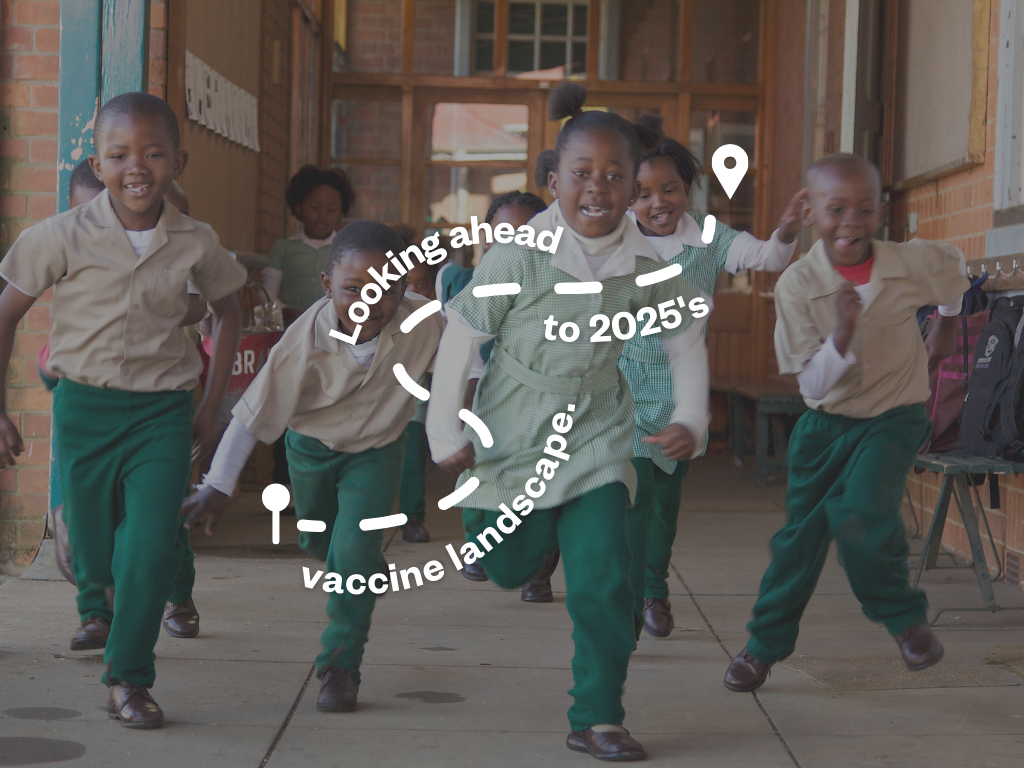Looking Back, Looking Ahead 2025
2024 saw many twists and turns in the global vaccine landscape. Another year come and gone, 2025 brings new challenges and new promises for global immunization.

As we reflect on the accomplishments of the past year, it becomes clear that 2024 was a year of progress, partnership, and perseverance in the fight against vaccine-preventable diseases. From the rollouts of new routine immunizations to standing strong through global conflict, we have made significant strides in the fight for vaccines for all.
But as we step into 2025, we know the journey is far from over. The road ahead holds exciting opportunities for even greater advances in immunization. Read on to reflect and look ahead towards key developments that we expect to shape the future of vaccines in 2025 and beyond.
Reflecting on 2024: Progress Paired with Hardship
2024 saw critical vaccine rollouts that continue to protect millions of lives. A standout achievement was the expansion of the malaria vaccine, RTS,S, in sub-Saharan Africa. With new evidence supporting the impact of both RTS,S and its counterpart, R21, this landmark development has the potential to save hundreds of thousands of lives and reduce the burden of malaria on communities that have long been at risk. Since first being piloted in Ghana, Malawi, and Kenya, RTS,S has seen a rapid rollout across the continent, while R21 is also rapidly gaining traction. In total, 17 endemic countries are now vaccinating against malaria.

In keeping with expanded rollouts, we also saw a historic feat in 2024: Chad became the first Gavi-supported country to pioneer a triple-vaccine rollout against pneumonia, malaria, and rotavirus. Not only is this an incredible and much-needed achievement in light of Chad’s high child mortality rates, but this initiative is paving the way for similar programs in other countries to maximize impact and efficiency.
But we cannot acknowledge the highs of 2024’s immunization progress without the lows. While recent years have shown impressive progress in the fight against diseases like polio and measles, conflict, poverty, and misinformation have taken their toll on coverage rates. The global polio eradication effort has been threatened in conflict-riddled areas like Gaza and South Sudan, and measles cases doubled globally in 2023 due to a fall in vaccination rates. But efforts are underway to combat both of these trends; in November 2024, UNICEF and WHO carried out a surge vaccination campaign in Gaza, vaccinating more than 500,000 children against polio in just nine weeks after the virus was detected. And efforts to increase measles immunization coverage have been fruitful in regions like South America, which is certified free of endemic measles.

Amid these victories and losses, we must remain vigilant. Global health threats are ever evolving, underscoring the need for innovation and continued collaboration.
Building Momentum in 2025
As we enter the new year, the global immunization landscape is poised for exciting developments. Here are some to look out for:
#1: New Vaccines on the Horizon
In 2025, we can anticipate the introduction of several new vaccines that may revolutionize the way we combat age-old infectious diseases. Perhaps the most anticipated is the long-awaited TB (tuberculosis) vaccine. After decades of research, there’s hope that the new BCG replacement vaccine, currently in the final stages of trials, could significantly reduce TB cases and deaths globally. The M72/AS01E vaccine—currently undergoing trails in seven countries, including South Africa and Kenya—could be a game-changer, particularly in regions where TB remains a major public health challenge.
A similarly long-awaited vaccine is on the horizon: the universal flu vaccine. Clinical trials are underway for a flu vaccine that would protect people from most strains of influenza A and B viruses, eliminate the need for annual vaccine updates, and generally help control global influenza outbreaks. The National Institute of Health began clinical trials for the vaccine back in 2023, and researchers are optimistic about continued progress this year.
Finally, the ongoing development of vaccines for dengue fever are expected to gain more traction in 2025. Brazil, Indonesia, and Thailand are at the forefront of dengue vaccine trials, and in 2025, we may see the expanded rollout of existing vaccines like Dengvaxia in regions with high transmission—a feat that has the potential to save countless lives as dengue cases rise.
#2: Improved Vaccine Access
Ensuring equitable access to vaccines is an ever-pertinent issue, and a priority in 2025. New efforts to improve cold-chain logistics and last-mile delivery systems will help ensure that vaccines reach even the most remote communities. For example, Gavi, the Vaccine Alliance, has an ongoing partnership with the Government of India to scale up delivery and demand in hopes of reducing the number of zero-dose children in the country by 30% by 2026—an effort that has proven successful so far. This is one of many nation-wide logistical undertakings that can guide parallel vaccine delivery strategies in other countries.
And new technology also spurs optimism for vaccine delivery; in countries like South Sudan, where only 8% of the population have access to grid electricity, an innovative solar-powered refrigeration system has been introduced to help store vaccines in rural areas, one of many new processes to make immunization more accessible to hard-to-reach populations.
This year, we also expect to see a continued push for self-administered vaccines and innovative delivery technologies such as needle-free injectors. According to Gavi Micro Array Patches (vaccine patches) could transform immunization in low-income countries, effectively reducing fear of injections and eliminating logistical complications that come with preserving traditional syringes.

Finally, while COVID-19 vaccination campaigns have shifted in 2025, the impact of the pandemic continues to shape immunization systems globally. In many sub-Saharan African countries, the lessons learned from the rapid rollout of COVID-19 vaccines are being applied to scale up immunization campaigns for childhood diseases like measles and polio, ensuring that the focus remains on both pandemic response and routine vaccination. And at the global level, efforts to ensure pandemic preparedness and response are still underway following the establishment of the Pandemic Accords and the WHO Country Office Strengthening Action Plan.
#3: Addressing Vaccine Hesitancy
A huge reason for falling vaccination coverage is vaccine hesitancy spurred by a lack of trust and exacerbated by rampant misinformation. In 2025, combatting this vaccine misinformation will remain a key challenge.
We find ourselves in a time where fake news, lies, conspiracy theories, misinformation and disinformation are rampant.
Dr. Tedros Adhanom Ghebreyesus, WHO Director-General
As the world embraces new vaccines, there exists a growing need to strengthen vaccine confidence through education, communication, and community engagement. Past successes in countries like Rwanda, which used to struggle with vaccine hesitancy at the start of the COVID-19 pandemic, but now has one of the highest vaccine acceptance ratings in the world, show the importance of ramping up efforts to combat vaccine misinformation via targeted public health campaigns.
Vaccine education continues to be especially pertinent in certain regions when it comes to more stigmatized diseases such as HPV or HIV. But countries like Lagos and Nigeria have grassroots vaccine awareness processes in-place that will continue into the new year—mothers, friends, and community members alike are educating children and their families both in and out of the classroom about the importance of vaccination, positively influencing coverage rates. This work will continue into 2025.
Let’s Make 2025 a Year of Impact
The road to global vaccine equity is long, but the reward is worth every step. It will take the commitment of governments, health organizations, communities, and individuals around the world to make 2025 a turning point in global immunization. Together, we can ensure that everyone, everywhere has a shot at life.

